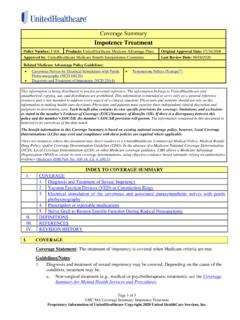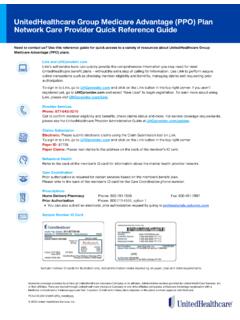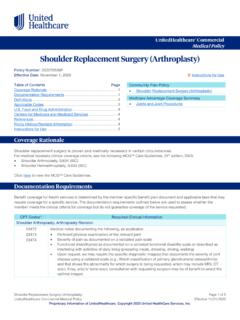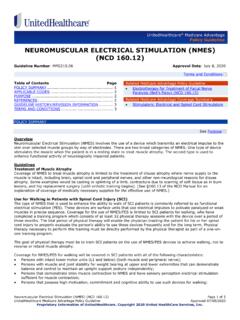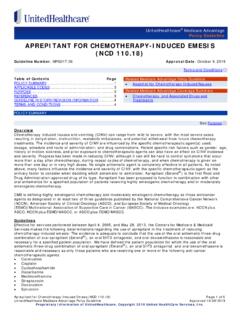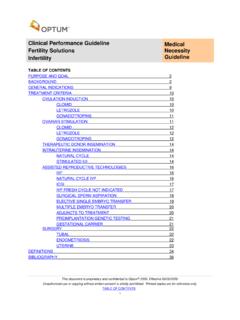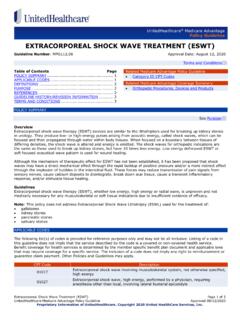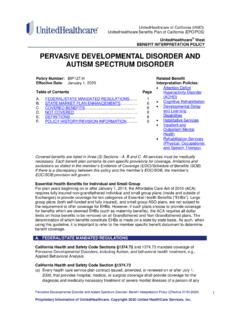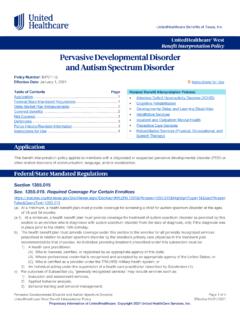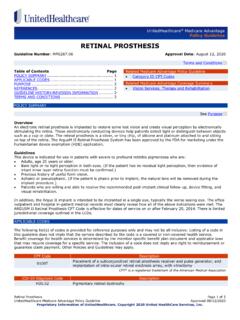Transcription of Magnetic Resonance Imaging (NCD 220.2) - UHCprovider.com
1 Magnetic Resonance Imaging (NCD ) Page 1 of 9 UnitedHealthcare Medicare Advantage Policy Guideline Approved 04/12/2023 Proprietary Information of UnitedHealthcare. Copyright 2023 United HealthCare Services, Inc. UnitedHealthcare Medicare Advantage Policy Guideline Magnetic Resonance Imaging (NCD ) Number: Approval Date: April 12, 2023 Terms and Conditions Table of Contents Page Policy Summary .. 1 Applicable Codes .. 4 References .. 7 Guideline History/Revision Information .. 8 Purpose .. 8 Terms and Conditions .. 9 Policy Summary See Purpose Overview Magnetic Resonance Imaging (MRI), formerly called nuclear Magnetic Resonance (NMR), is a non-invasive method of graphically representing the distribution of water and other hydrogen-rich molecules in the human body. In contrast to conventional radiographs or computed tomography (CT) scans, in which the image is produced by x-ray beam attenuation by an object, MRI is capable of producing images by several techniques.
2 In fact, various combinations of MRI image production methods may be employed to emphasize particular characteristics of the tissue or body part being examined. The basic elements by which MRI produces an image are the density of hydrogen nuclei in the object being examined, their motion, and the relaxation times, and the period of time required for the nuclei to return to their original states in the main, static Magnetic field after being subjected to a brief additional Magnetic field. These relaxation times reflect the physical-chemical properties of tissue and the molecular environment of its hydrogen nuclei. Only hydrogen atoms are present in human tissues in sufficient concentration for current use in clinical MRI. Magnetic Resonance Angiography (MRA) is a non-invasive diagnostic test that is an application of MRI. By analyzing the amount of energy released from tissues exposed to a strong Magnetic field, MRA provides images of normal and diseased blood vessels, as well as visualization and quantification of blood flow through these vessels.
3 Overall, MRI is a useful diagnostic Imaging modality that is capable of demonstrating a wide variety of soft-tissue lesions with contrast resolution equal or superior to CT scanning in various parts of the body. Among the advantages of MRI are the absence of ionizing radiation and the ability to achieve high levels of tissue contrast resolution without injected iodinated radiological contrast agents. Recent advances in technology have resulted in development and Food and Drug Administration (FDA) approval of new paramagnetic contrast agents for MRI which allow even better visualization in some instances. Multislice Imaging and the ability to image in multiple planes, especially sagittal and coronal, have provided flexibility not easily available with other modalities. Because cortical (outer layer) bone and metallic prostheses do not cause distortion of MR images, it has been possible to visualize certain lesions and body regions with greater certainty than has been possible with CT.
4 The use of MRI on certain soft tissue structures for the purpose of detecting disruptive, neoplastic, degenerative, or inflammatory lesions has now become established in medical practice. Phase contrast (PC) and time-of-flight (TOF) are some of the available MRA techniques at the time these instructions are being issued. PC measures the difference between the phases of proton spins in tissue and blood and measures both the venous and Related Medicare Advantage Reimbursement Policy Multiple Procedure Payment Reduction (MPPR) for Diagnostic Imaging Policy, Professional Magnetic Resonance Imaging (NCD ) Page 2 of 9 UnitedHealthcare Medicare Advantage Policy Guideline Approved 04/12/2023 Proprietary Information of UnitedHealthcare. Copyright 2023 United HealthCare Services, Inc. arterial blood flow at any point in the cardiac cycle. TOF measures the difference between the amount of magnetization of tissue and blood and provides information on the structure of blood vessels, thus indirectly indicating blood flow.
5 Two-dimensional (2D) and three-dimensional (3D) images can be obtained using each method. Contrast-enhanced MRA (CE-MRA) involves blood flow Imaging after the patient receives an intravenous injection of a contrast agent. Gadolinium, a non-ionic element, is the foundation of all contrast agents currently in use. Gadolinium affects the way in which tissues respond to magnetization, resulting in better visualization of structures when compared to un-enhanced studies. Unlike ionic ( , iodine-based) contrast agents used in conventional contrast angiography (CA), allergic reactions to gadolinium are extremely rare. Additionally, gadolinium does not cause the kidney failure occasionally seen with ionic contrast agents. Digital subtraction angiography (DSA) is a computer-augmented form of CA that obtains digital blood flow images as contrast agent courses through a blood vessel. The computer subtracts bone and other tissue from the image, thereby improving visualization of blood vessels.
6 Physicians elect to use a specific MRA or CA technique based upon clinical information from each patient. Coverage is limited to MRI units that have received Food and Drug Administration (FDA) premarket approval, and such units must be operated within the parameters specified by the approval. Other uses of MRI for which CMS has not specifically indicated national coverage or national non-coverage are at the discretion of Medicare s local contractors. Nationally Covered MRI and MRA Indications MRI Examination of the head, central nervous system, and spine. Multiple sclerosis can be diagnosed with MRI and the contents of the posterior fossa are visible. The inherent tissue contrast resolution of MRI makes it an appropriate standard diagnostic modality for general neuroradiology. Establishing a differential diagnosis of mediastinal and retroperitoneal masses, including abnormalities of the large vessels such as aneurysms and dissection. When a clinical need exists to visualize the parenchyma of solid organs to detect anatomic disruption or neoplasia, this can be accomplished in the liver, urogenital system, adrenals, and pelvic organs without the use of radiological contrast materials.
7 The use of paramagnetic contrast materials may be covered as part of the study. MRI may also be used to detect and stage pelvic and retroperitoneal neoplasms and to evaluate disorders of cancellous bone and soft tissues. It may also be used in the detection of pericardial thickening. Primary and secondary bone neoplasm and aseptic necrosis can be detected at an early stage and monitored with MRI. Patients with metallic prostheses, especially of the hip, can be imaged in order to detect the early stages of infection of the bone to which the prosthesis is attached. Gating devices and surface coils, that eliminate distorted images caused by cardiac and respiratory movement cycles may be covered. Surface and other specialty coils may also be covered, as they are used routinely for high resolution Imaging where small limited regions of the body are studied. They produce high signal-to-noise ratios resulting in images of enhanced anatomic detail. Diagnosing disc disease without regard to whether radiological Imaging has been tried first to diagnose the problem.
8 MRA (MRI for Blood Flow) Evaluation of the carotid arteries, the circle of Willis, the anterior, middle or posterior cerebral arteries, the vertebral or basilar arteries or the venous sinuses. Pre- operative evaluation for conditions including, but not limited to, tumor, aneurysms, vascular malformations, vascular occlusion or thrombosis. Determination of the presence and extent of peripheral vascular disease in lower extremities. Pre- operative evaluation of patients undergoing elective abdominal aortic aneurysm (AAA) repair. Imaging the renal arteries and the aortoiliac arteries. Diagnosing a suspected pulmonary embolism when it is contraindicated for the patient to receive intravascular iodinated contrast material for a pulmonary angiogram. Pre- operative and post - operative evaluation of thoracic aortic dissection of aneurysm. Magnetic Resonance Imaging (NCD ) Page 3 of 9 UnitedHealthcare Medicare Advantage Policy Guideline Approved 04/12/2023 Proprietary Information of UnitedHealthcare.
9 Copyright 2023 United HealthCare Services, Inc. MRI for Patients with an Implanted Pacemaker, Implantable Cardioverter Defibrillator (ICD), Cardiac Resynchronization Therapy Pacemaker (CRT-P), or Cardiac Resynchronization Therapy Defibrillators (CRT-D) Effective for claims with dates of service on or after April 10, 2018, CMS determined the evidence is sufficient to conclude that MRI for patients with an Implanted Pacemaker (PM), Implantable Cardioverter Defibrillator (ICD), Cardiac Resynchronization Therapy Pacemaker (CRT-P), or Cardiac Resynchronization Therapy Defibrillator (CRT-D) is reasonable and necessary under certain circumstances. An MRI is covered when used according to the FDA labeling in an MRI environment for patients with an implanted pacemaker, implantable cardioverter defibrillator (ICD) cardiac resynchronization therapy pacemaker (CRT-P), or cardiac resynchronization therapy defibrillator (CRT-D). Any MRI for patients with an implanted pacemaker, ICD, CRT-P, or CRT-D that does not have FDA labeling specific to use in an MRI environment is only covered under the following conditions: o MRI field strength is Tesla using Normal Operating Mode; o The implanted pacemaker, ICD, CRT-P, or CRT-D system has no fractured, epicardial, or abandoned leads; o The facility has implemented a checklist which includes the following: Patient assessment is performed to identify the presence of an implanted pacemaker, ICD, CRT-P, or CRT-D; Before the scan benefits and harms of the MRI scan are communicated with the patient or the patient s delegated decision-maker; Prior to the MRI scan, the implanted pacemaker, ICD, CRT-P, or CRT-D is interrogated and programmed into the appropriate MRI scanning mode.
10 A qualified physician, nurse practitioner, or physician assistant with expertise with implanted pacemakers, ICDs, CRT-Ps, or CRT-Ds must directly supervise the MRI scan as defined in 42 CFR and ; Patients are observed throughout the MRI scan via visual and voice contact and monitored with equipment to assess vital signs and cardiac rhythm; An advanced cardiac life support provider must be present for the duration of the MRI scan; A discharge plan that includes before being discharged from the hospital/facility, the patient is evaluated and the implanted pacemaker, ICD, CRT-P, or CRT-D is reinterrogated immediately after the MRI scan to detect and correct any abnormalities that might have developed. Contraindications and Nationally Non-Covered Indications Compliance with the provisions in this policy is subject to monitoring by post payment data analysis and subsequent medical review. Title XVIII of the Social Security Act, Section 1862(a)(1)(A) states ".
